The IoT Application Enablement Market is estimated to be valued at USD 5.7 billion in 2025 and is projected to reach USD 58.7 billion by 2035, registering a compound annual growth rate (CAGR) of 26.3% over the forecast period.
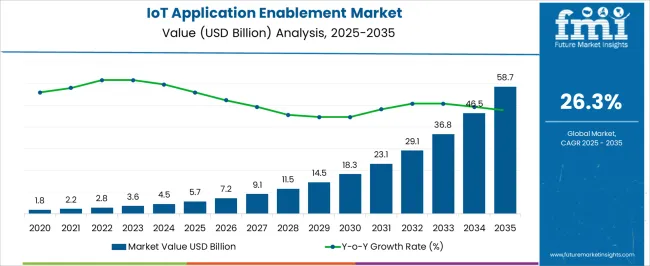
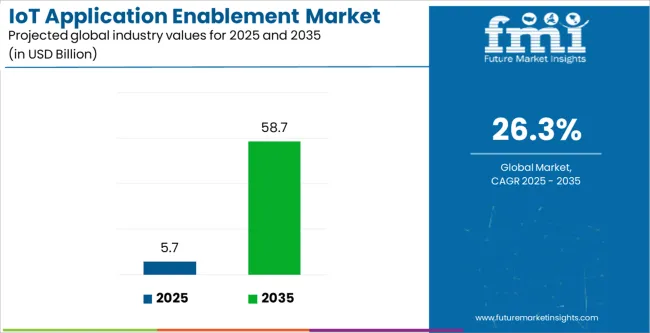
| Metric | Value |
|---|---|
| IoT Application Enablement Market Estimated Value in (2025 E) | USD 5.7 billion |
| IoT Application Enablement Market Forecast Value in (2035 F) | USD 58.7 billion |
| Forecast CAGR (2025 to 2035) | 26.3% |
The IoT application enablement market is advancing rapidly, propelled by the need for scalable platforms that allow enterprises to manage, integrate, and deploy connected device solutions efficiently. Industry publications and technology company reports have emphasized the growing role of IoT enablement in accelerating digital transformation across industries. The ability to collect, process, and analyze real-time data has supported operational optimization and improved decision-making, making IoT platforms a cornerstone of Industry 4.0 adoption.
Increasing cloud integration, advancements in edge computing, and the proliferation of 5G networks have enhanced the capabilities of IoT application enablement, offering faster processing and reduced latency. Investor briefings have highlighted growing demand among SMEs seeking cost-effective solutions to connect and monitor assets without heavy infrastructure investment.
Additionally, manufacturing and industrial sectors have embraced IoT enablement to drive automation, predictive maintenance, and supply chain efficiency. Looking forward, the market is expected to be shaped by the integration of AI-driven analytics, low-code development platforms, and heightened focus on cybersecurity within IoT ecosystems.
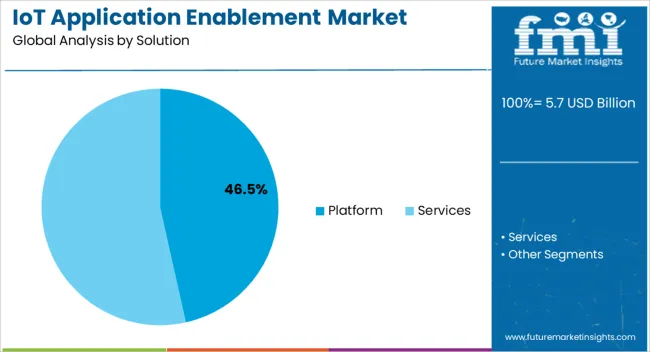
The Platform segment is projected to contribute 46.50% of the IoT application enablement market revenue in 2025, retaining its leadership within the solution category. Growth of this segment has been driven by the need for centralized, scalable, and interoperable frameworks that enable enterprises to connect heterogeneous devices and applications seamlessly. Platforms have offered capabilities for data integration, device management, and application development, reducing time-to-market for IoT solutions.
Technology company disclosures have shown that enterprises are increasingly adopting platform-based approaches to minimize development complexities and enhance scalability. The flexibility of platforms in supporting multi-cloud and hybrid deployments has also been valued, ensuring smooth integration with existing IT environments.
With the rise of low-code and no-code IoT application platforms, enterprises have gained the ability to innovate faster and expand use cases across diverse industries. These attributes have firmly established the Platform segment as the backbone of IoT application enablement.
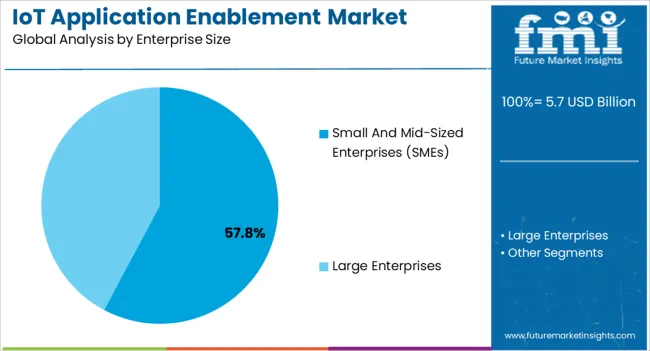
The Small and Mid-Sized Enterprises (SMEs) segment is projected to account for 57.80% of the IoT application enablement market revenue in 2025, positioning it as the dominant enterprise size category. This growth has been supported by the increasing accessibility of cost-efficient IoT platforms that allow SMEs to adopt digital transformation strategies without significant upfront investment.
Reports from technology providers have indicated that SMEs are leveraging IoT to streamline operations, monitor assets, and improve customer engagement. Cloud-based platforms and subscription-based models have lowered barriers to entry, making IoT deployment feasible for smaller businesses.
Additionally, the competitive landscape has pushed SMEs to adopt IoT solutions to enhance productivity and remain agile in dynamic markets. Government programs and digitalization incentives targeting SMEs have further accelerated adoption. With IoT use cases ranging from smart logistics to energy management, the SME segment is expected to continue its leadership, underpinned by scalability, affordability, and strong ROI.
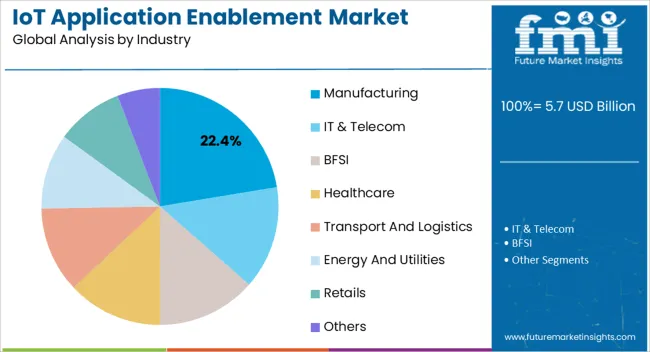
The Manufacturing segment is projected to hold 22.40% of the IoT application enablement market revenue in 2025, establishing itself as the leading industry vertical. Growth of this segment has been driven by the adoption of IoT for predictive maintenance, production optimization, and quality control within manufacturing environments.
Industry 4.0 initiatives have emphasized the integration of IoT platforms to enable real-time visibility across production lines, enhancing efficiency and reducing downtime. Manufacturing companies have also adopted IoT enablement solutions to strengthen supply chain transparency and inventory management.
Analyst presentations and corporate press releases have reported significant investment in smart factory projects, highlighting IoT as a foundational technology. Furthermore, the use of IoT data analytics has enabled manufacturers to enhance product lifecycle management and reduce operational costs. As global manufacturing continues its shift toward automation and connected ecosystems, the Manufacturing segment is expected to remain at the forefront of IoT application enablement adoption.
Sales in the IoT application enablement market are estimated to rise at a 27.5% CAGR between 2025 and 2035, in comparison with the 23.7% CAGR registered between 2020 to 2025. This attributes to the growing adoption of IoT applications among large as well as small and mid-sized enterprises (SMEs) across the globe.
Application Enablement Platform (AEP) or IoT application enablement platform is a form of platform-as-a-service that help businesses to develop their businesses with IoT and can help to provide a clear vision to an IoT solution.
By enterprise size, demand in the SME segment is expected to grow at the highest CAGR of 29.0% during the forecast period. By solution, sales in the IoT application enablement platform segment are expected to grow at a CAGR of 27.7% over the forecast period.
IoT platforms help to streamline the functioning of IoT solutions and build IoT projects cheaper, faster, and better. The essential capabilities/features include network and connectivity management, data acquisition, device management, application enablement, processing visualization, and analysis, integration, and storage.
IoT platforms have become the backbone of professional IoT deployments, with more IoT devices, data, assets-related technologies, connectivity/network solutions, and infrastructural and architectural evolutions. Many businesses are adopting IoT platforms, and as a result of which, the demand for the IoT application enablement platform is increasing.
Smart city networks use IoT technology in a variety of ways. One of the key challenges is traffic monitoring. The ability to monitor traffic using sensors located around the city allows improved control of intersections and traffic optimization. Monitoring water levels can also assist in detecting and informing communities about possible and active floods.
In smart cities and smart homes, IoT devices are used to detect and monitor weather conditions, conduct surveillance, and host public Wi-Fi. Thus, the rising adoption of IoT devices in smart homes and smart cities are poised to continue fueling sales in the market.
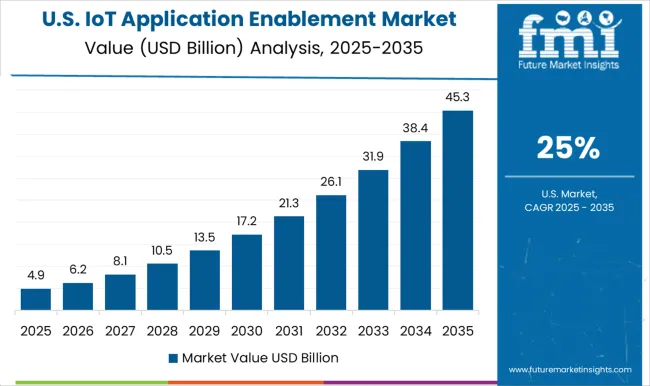
Rising Adoption of IoT Application Enablement Services in the United States is expected to Boost Sales
Sales in the United States market are projected to increase at a CAGR of 20% over the forecast period, reaching a valuation of USD 5.7 million in 2025.
The United States is one of the most developed countries considering infrastructure for advanced technologies. The presence of key application enablement platform providers including Amazon Web Services, IBM, Microsoft, and Oracle is assumed to drive product innovation in the market.
The presence of such prominent IoT application enablement solutions providers is ultimately projected to fuel the demand for IoT application enablement platforms.
Increasing Preference for IoT Application Enablement Solutions in the United Kingdom is anticipated to Fuel Growth
Demand in the United Kingdom market is anticipated to grow at a 34% CAGR over the forecast period, creating an absolute dollar opportunity of USD 2.5 billion during the assessment period. The rising adoption of connective technologies such as artificial intelligence (AI) and machine learning (ML) is expected to fuel sales in the market.
For instance, the United Kingdom government launched a national program named IoT United Kingdom. Under this program, the United Kingdom Government has planned to invest 40 million pounds for the procurement and deployment of the Internet of Things (IoT). Thus, government initiatives and increasing adoption of innovative IoT technologies are projected to augment the growth in the market.
Rapid Emergence of Startups in India is expected to Spur Demand for IoT Application Enablement Solution
India is set to emerge as a lucrative pocket in the South Asia market, with demand growing at a 32% CAGR over the assessment period. Rising government initiatives to encourage the adoption of advanced technologies such as big data, AI, the Internet of Things (IoT), and others are poised to augment sales in the market.
Initiatives such as Make in India, Digital India, IoT Centre of Excellence by NAAACOM, and many more are fueling growth in the IoT ecosystem in India, along with 5G technology development. Based on the aforementioned factors, sales in India are expected to increase at a considerable pace over the assessment period.
Sales of IoT Application Enablement Solutions to Remain High
Based on the solution, demand in the IoT application enablement platform segment increased by 11.5x, with sales growing at a 28% CAGR over the forecast period.
IoT application enablement platform helps enterprises unify multi-vertical operations, offer a uniform point of entry, power custom workflows, make organizational learning easy, and build flexible cores.
Adoption of IoT Application Enablement Platform Across Large Enterprises is Assumed to Gain Traction
Based on enterprise size, demand in the large enterprise segment is anticipated to increase by 9.1X, rising at a 29.5% CAGR through 2035.
IoT application enablement platform enables cost reduction, efficiency and productivity, enhanced customer experience, mobility, and agility. Therefore, large enterprises have the largest market share in 2025.
Demand for IoT Application Enablement Solutions in the Manufacturing Sector Will is Anticipated to increase
Based on industry, the manufacturing segment will expand by 12.2x, with sales growing at a 34.5% CAGR over the forecast period.
IoT applications in the manufacturing industry include intelligent product enhancements, dynamic response to market demand, improved facility service, lower costs, waste reduction and optimized resource use, quality control, predictive maintenance, and inventory management.
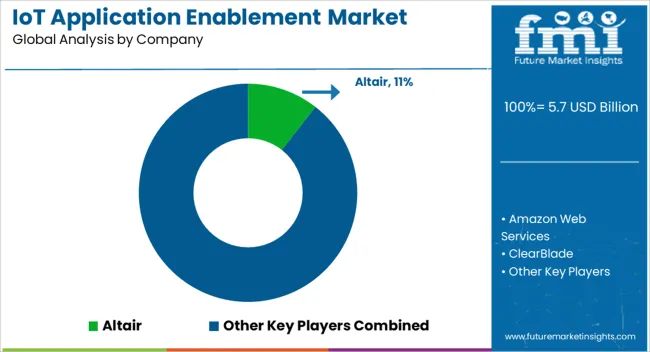
Key IoT application enablement solution providers are focusing on investing in research and development and innovation to offer various solutions for industrial applications. For instance:
| Attribute | Details |
|---|---|
| Estimated Market Size (2025) | USD 3.5 billion |
| Projected Market Valuation (2035) | USD 40.5 billion |
| Growth Rate | CAGR of 27.5% from 2025 to 2035 |
| Forecast Period | 2025 to 2035 |
| Historical Data Available for | 2020 to 2025 |
| Report Coverage | Market Forecast, Company Share Analysis, Competition Intelligence, Drivers, Restraints, Opportunities and Threats Analysis, Market Dynamics and Challenges, and Strategic Growth Initiatives |
| Market Analysis | USD billion for Value |
| Key Regions Covered | North America; Latin America; Western Europe; Eastern Europe; South Asia & Pacific; East Asia; Middle East & Africa |
| Key Countries Covered | United States, Canada, Brazil, Mexico, Germany, United Kingdom, France, Spain, Italy, Poland, Russia, Czech Republic, Romania, India, Bangladesh, Australia, New Zealand, China, Japan, South Korea, GCC Countries, South Africa, Israel |
| Key Segments Covered | Solution, Enterprise Size, Industry, Region |
| Key Companies Profiled | Altair; Amazon Web Services; ClearBlade; Ericsson; Fujitsu; IBM; Microsoft; Oracle Corporation; PTC; SAP; Siemens; AllThingsTalk; Hughes Systique Corporation; Software AG |
| Customization & Pricing | Available upon Request |
The global IoT application enablement market is estimated to be valued at USD 5.7 billion in 2025.
The market size for the IoT application enablement market is projected to reach USD 58.7 billion by 2035.
The IoT application enablement market is expected to grow at a 26.3% CAGR between 2025 and 2035.
The key product types in IoT application enablement market are platform, _cloud-based, _on-premises, services, _professional service and _managed services.
In terms of enterprise size, small and mid-sized enterprises (smes) segment to command 57.8% share in the IoT application enablement market in 2025.






Full Research Suite comprises of:
Market outlook & trends analysis
Interviews & case studies
Strategic recommendations
Vendor profiles & capabilities analysis
5-year forecasts
8 regions and 60+ country-level data splits
Market segment data splits
12 months of continuous data updates
DELIVERED AS:
PDF EXCEL ONLINE
IoT Spend by Logistics Market Size and Share Forecast Outlook 2025 to 2035
IoT Chip Market Size and Share Forecast Outlook 2025 to 2035
IoT Device Management Market Size and Share Forecast Outlook 2025 to 2035
IoT In Aviation Market Size and Share Forecast Outlook 2025 to 2035
IoT Processor Market Size and Share Forecast Outlook 2025 to 2035
IoT in Manufacturing Market Size and Share Forecast Outlook 2025 to 2035
IoT For Cold Chain Monitoring Market Size and Share Forecast Outlook 2025 to 2035
IoT Connectivity Management Platform Market Size and Share Forecast Outlook 2025 to 2035
IoT-based Asset Tracking and Monitoring Market Size and Share Forecast Outlook 2025 to 2035
IoT In Construction Market Size and Share Forecast Outlook 2025 to 2035
IoT Device Management Platform Market Size and Share Forecast Outlook 2025 to 2035
IoT Testing Equipment Market Size and Share Forecast Outlook 2025 to 2035
IoT Development Kit Market Size and Share Forecast Outlook 2025 to 2035
IoT in Utilities Market Size and Share Forecast Outlook 2025 to 2035
IoT in Product Development Market Analysis - Growth & Forecast 2025 to 2035
IoT Communication Protocol Market - Insights & Industry Trends 2025 to 2035
IoT in Healthcare Market Insights - Trends & Forecast 2025 to 2035
IoT Network Management Market – Growth & Forecast through 2034
IoT for Public Safety Market
IoT Data Governance Market

Thank you!
You will receive an email from our Business Development Manager. Please be sure to check your SPAM/JUNK folder too.
Chat With
MaRIA